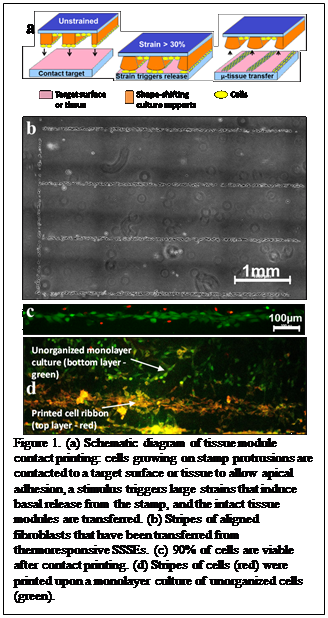Dynamic Tissue Cultures for Cell Printing
Ryan Toomey, Associate Professor
Department of Chemical & Biomedical Engineering
University of South Florida, Tampa, Florida 33620
toomey@usf.edu;813.974.9164
 Overview of The Toomey Group: Our long-term goal is to develop effective strategies for engineering complex tissues for the regeneration of organs. No known technology has successfully achieved the ability to print 3-dimensional tissues. We are currently investigating the fabrication of tissues using a “μ-tissue stamp.” The stamp is constructed from arrays of shape-shifting surface extrusions (SSSEs) (Fig. 1) that promote the formation of patterned tissue building blocks. Contact printing of the building blocks is enabled through a shape-shift in the surface extrusions, which releases the organized tissue modules through a mechanical, strain-based mechanism that modulates cell adhesion.
Overview of The Toomey Group: Our long-term goal is to develop effective strategies for engineering complex tissues for the regeneration of organs. No known technology has successfully achieved the ability to print 3-dimensional tissues. We are currently investigating the fabrication of tissues using a “μ-tissue stamp.” The stamp is constructed from arrays of shape-shifting surface extrusions (SSSEs) (Fig. 1) that promote the formation of patterned tissue building blocks. Contact printing of the building blocks is enabled through a shape-shift in the surface extrusions, which releases the organized tissue modules through a mechanical, strain-based mechanism that modulates cell adhesion.
Teacher Project: Study of cell release mechanism.
The goal of this project for the teacher is to help us identify the mechanisms by which cells are released from the SSSEs. The teacher will work closely with 2 graduate students and will learn how to synthesize the SSSEs, how to culture cells on the SSSEs, and validate hypothesis of cell release mechanisms.
All facilities will be in-place for the teacher to start the project immediately. The first few days will be spent on re-reading a few relevant journal articles (which will be provided ahead of time), training on laboratory equipment, and discussions with Prof. Toomey and the graduate students.
This is a highly interdisciplinary project, and the teacher will also interact with collaborators from the department of Mechanical Engineering (Dr. Nathan Gallant) and the Department of Physics (Dr. Garrett Matthews).
Depending upon progress, co-authorship of a conference presentation and a journal article are possible for the teacher, from this project.
- 1. Upconversion Photocatalysis for Energy and Environmental Applications
- 2. Sorption of Organic Vapors by Polymers using a Quartz Crystal Microbalance
- 3. Effective Deposition and Spreading of Powder Layers for 3D Printing
- 4. Synthesis and Characterization of Structured Nanomaterials for Energy Applications
- 5. Syntheses and Characterizations of Catalytically Active Porous Metal-Organic Frameworks (MOFs)
- 6. Microfluidic Filtration of Circulating Tumor Cells
- 7. Simulation and Rational Design of Metal-Organic Materials
- 8. Composition of Organic and Inorganic Polymeric Nanofibers for Filtering, Tissue Scaffolding, Wavelength Reflecting, and Self-healing Functionalities
- 9. Dynamic Tissue Cultures for Cell Printing
- 10. Synthesis and Characterization of Nanocomposites for 3D Printed RF Devices